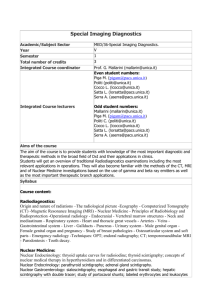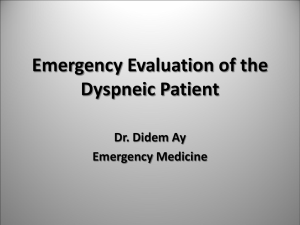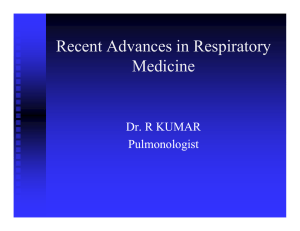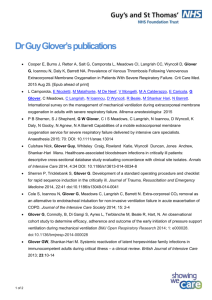Diseases of the Respiratory and Cardiovascular Systems
advertisement
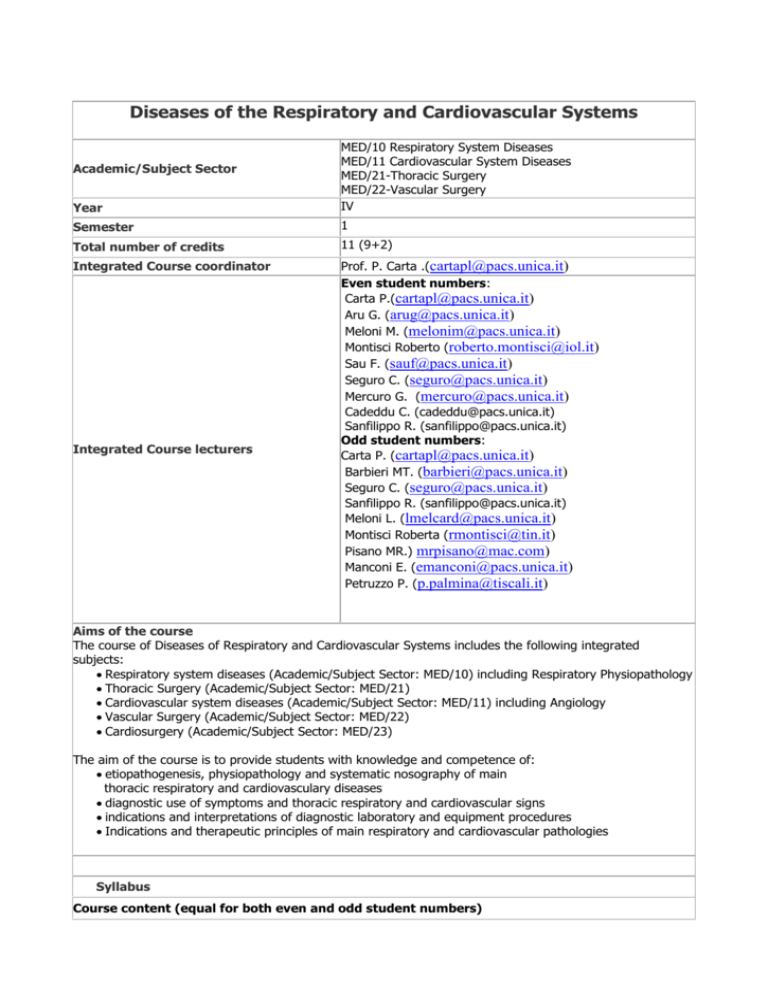
Diseases of the Respiratory and Cardiovascular Systems Year MED/10 Respiratory System Diseases MED/11 Cardiovascular System Diseases MED/21-Thoracic Surgery MED/22-Vascular Surgery IV Semester 1 Total number of credits 11 (9+2) Integrated Course coordinator Prof. P. Carta .(cartapl@pacs.unica.it) Even student numbers: Carta P.(cartapl@pacs.unica.it) Aru G. (arug@pacs.unica.it) Meloni M. (melonim@pacs.unica.it) Montisci Roberto (roberto.montisci@iol.it) Sau F. (sauf@pacs.unica.it) Seguro C. (seguro@pacs.unica.it) Mercuro G. (mercuro@pacs.unica.it) Cadeddu C. (cadeddu@pacs.unica.it) Sanfilippo R. (sanfilippo@pacs.unica.it) Odd student numbers: Carta P. (cartapl@pacs.unica.it) Barbieri MT. (barbieri@pacs.unica.it) Seguro C. (seguro@pacs.unica.it) Sanfilippo R. (sanfilippo@pacs.unica.it) Meloni L. (lmelcard@pacs.unica.it) Montisci Roberta (rmontisci@tin.it) Pisano MR.) mrpisano@mac.com) Manconi E. (emanconi@pacs.unica.it) Petruzzo P. (p.palmina@tiscali.it) Academic/Subject Sector Integrated Course lecturers Aims of the course The course of Diseases of Respiratory and Cardiovascular Systems includes the following integrated subjects: Respiratory system diseases (Academic/Subject Sector: MED/10) including Respiratory Physiopathology Thoracic Surgery (Academic/Subject Sector: MED/21) Cardiovascular system diseases (Academic/Subject Sector: MED/11) including Angiology Vascular Surgery (Academic/Subject Sector: MED/22) Cardiosurgery (Academic/Subject Sector: MED/23) The aim of the course is to provide students with knowledge and competence of: etiopathogenesis, physiopathology and systematic nosography of main thoracic respiratory and cardiovasculary diseases diagnostic use of symptoms and thoracic respiratory and cardiovascular signs indications and interpretations of diagnostic laboratory and equipment procedures Indications and therapeutic principles of main respiratory and cardiovascular pathologies Syllabus Course content (equal for both even and odd student numbers) The course will cover the basics of the following topics: ־Anatomopathological, physiopathological and clinical classification ־Description of essential epidemiological data ־Enumeration and description of risk factors and etiologic agents ־Presentation of pathogenetic and physiopathological processes for the understanding of clinical pictures ־Description of the anatomo-pathological pictures and the anatomo-functional correlations ־Description of symptoms and natural history ־Planning of investigations required for the diagnosis and functional assessment ־Principles and basics of prevention and therapy Respiratory Physiopathology: Basic diagnostic methods with patients affected by thoracic respiratory disorders and pathologies Indications and physiopathological interpretations of main diagnostic methods and thoracicpulmonary investigations with a focus on ventilatory function tests, CO alveolar-capillary diffusion, arterial hemogasanalysis, bronchial provocation test, sputum analysis, imaging diagnostics and equipment tests Definition, physiopathological mechanisms, classification and methods of diagnosis; treatment of acute and chronic respiratory insufficiency. Respiratory System Diseases: Infectious pathologies, Bacterial and viral pneumonia. Pulmonary tubercolosis. Pleuritis and pleuric effusions. Chronic Obstructive Bronchopneumopathies (COBP): chronic bronchitis, emphysema; Bronchial asthma, Bronchiectasy. Interstitial lung diseases. Pneumoconiosis and hypersensitivity pneumomitis. Thoracic traumas. Pneumothorax, Lung Abscess, Pleuric Empyema, Hydatidosis. Mediastinal pathology. Pulmonary carcinoma. Thoracic Surgery: Heart and vessels diseases Atherosclerotic disease: risk factors, prevention, treatment. Arterial hypertension. Pericarditis, myocarditis and Endocarditis. Ischemic cardiopathy. Cardiomyopathies. Valvular heart diseases. Cardiac decompensation. Rhythm and conduction disorders. Non-invasive vascular diagnostics of arteriopathies. Acute and chronic arteriopathies. Deep venous thrombosis (DVT). Lower limb varices and venous insufficiency. Limb lymphedemas. Ulcers, necrosis and gangrenes. Chronic obstructive arteriopathy in lower limbs. Acute artery ischemia. Intestinal ischemic syndromes. Aneurysm and pseudoaneurysm. Aortic aneurysms; infrarenal aortic aneurysms; Thoracic aortic aneurysms. Peripheral and visceral aneurysms. Popliteal, subclavian, splenic, renal and mesenteric artery aneurysm. Dissecting aortic aneurysm. Vascular Surgery: Obstruction of supra-aortic trunks. Thoracic outlet syndrome (TOS). Angioplasty and coronary stenting. Aortocoronanry bypass. Extracorporeal circulation. Cardiac transplantation. Valve replacements. Cardiosurgery Reference texts Harrison: Medicina Interna (Mc Graw-Hill); JB West:Fisiopatologia respiratoria (Piccin); L Casali: Manuale di Malattie dell’apparato respiratorio (Masson); Bellia V, Bonsignore G.: Malattie dell’apparato respiratorio, Mc Graw-Hill 2006; Dionigi R.: “Chirurgia” III Edizione Masson 2002; S Dalla Volta: Malattie del cuore e dei vasi (Mc Graw-Hill); Fegiz – Marrano – Ruberti: Manuale di chirurgia generale (Piccin); Colombo-Paletto: Trattato di chirurgia (UTET). Practical and theoretical skills are developed during seminar activities on specific topics and clinical cases, which will apply interactive teaching methods in small groups. These seminars will also be included in the optional teaching courses offered by individual lecturers. Teaching methods Assessment methods Requirements to take the exam Language of instruction Where we are Interactive teaching centre: Professional training activity will take place in specific wards and laboratories, where students will learn theoretical and practical skills to use and interpret: the manoeuvres used for the physical examination of respiratory and cardiovascular systems, respiratory function tests, invasive and non invasive equipment and diagnostic imaging investigations, respiratory and cardiovascular system diseases of internal and surgical relevance. Students will actively supervise and take part in diagnostic investigations regarding patients admitted to hospital and outpatient's departments and, if possible, supervise thoracic pulmonary and vascular surgical operations. In-sessional tests (arranged by lecturers) and final oral exam Students must have taken the exams of Pathology and Physiopathology and Clinical Methodology. Italian Servizio di Medicina preventiva dei lavoratori e di Fisiopatologia respiratoria: Blocco G Monserrato Reparto di Medicina del lavoro: blocco G Monserrato Reparto di Cardiologia del Policlinico di Monserrato Reparto di Chirurgia vascolare del Policlinico di Monserrato Reparto di Cardiologia del S. Giovanni di Dio Further information
